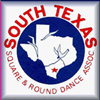

The South Texas Square and Round Dance Association was organized on February 11, 1949, by thirty-eight dancers, representing eight clubs.
Early leaders and callers dating back to 1947 include the Knapps, Tuckers, Crabbs and Brooks of Corpus Christi and the Calvins and Mc Douglases of Kingsville.
First Officers:
President . . . . . . . . . . . J. C. Tucker
Vice President . . . . . . . Roger S. Knapp
Secretary/Treasurer . . .W. P. Witt
The South Texas Association Charter Dance was held March, 1949, in Corpus Christi with the Kingsville Band providing live music for the dance. The Association showed a profit of $ 484.42, which was a lot of money in the post war era. As of February 8, 1951, the South Texas Association was comprised of forty-three clubs; sixteen from Corpus Christi and four from the Kingsville-Bishop area. For years, membership exceeded six hundred.
Many changes have been made since those days. In the early years, there were few or no lessons available. No club officers and no air conditioning. Of course, dancing was the main interest. How many of you have danced from 7:30 P.M. until 12:30 A.M. on a warm August evening? That’s about five hours, twenty-eight tips and fourteen couples dancing in nature’s own air conditioning.
On January 8, 1952, the South Texas Association was dissolved and reorganized into two groups. As a result, the Valley Square Dance Association, which later became the Magic Valley Square and Round Dance Association, was established.
South Texas joined the Texas State Federation in 1953. The first delegates to the State Festival on May 18, 1963, were the Millers , Van Cleaves, Hurds and the Deislers. Since that time, South Texas has hosted State Conclaves, President’s meetings and several State Festivals.
In the early days of square dancing, the number of callers was few and most dancers could learn the basic calls quickly. Now there are many different levels of square dancing. It takes more time to learn the basic calls, but the same thing applies today, just as it did in the early years, that is, to go dancing and have fun.
The people who square dance come from all walks of life. They still go for the good, clean family fun and fellowship that has always been associated with square dancing, from the beginning. This tradition will continue, for all time, as long as there are square dancers.
HAPPY DANCING